Has something been munching on Pluto?
Loading...
Forget the moon being made out of tasty cheese, a closer look at images snapped from NASA's New Horizons spacecraft suggests something found another planetary body worth snacking on: Pluto.
It may appear as if something has nibbled on the dwarf planet, but NASA scientists have another explanation for the unique feature.
Piri Planitia, a flat, geologically young region on Pluto with jagged cliffs marking its edges, looks like a bite mark, but may actually be the result of a different force: sublimation, NASA officials suggest in a press release.
Sublimation is the process of a solid substance transforming into a gas without passing through a liquid phase. The surface of this region is rich with methane ice. If that is sublimating, becoming atmospheric methane, and revealing a lower layer of water-ice, that could explain why Piri Planitia looks like a bite mark.
The NASA press release explains that data from the New Horizons spacecraft’s Linear Etalon Imaging Spectral Array, known affectionately as Ralph, shows that the apparent cliffs are rich in methane ice and the plains have more water ice. If the methane ice is sublimating, those cliffs would slide south, expanding the water-ice rich plains. And this would explain why the feature appears to be geologically young, with few impact craters.
This data could also suggest a sort of water ice bedrock lies beneath Pluto's surface in this region. Because it's so cold on the surface of the dwarf planet, the water ice is solid like a rock.
Piri Planitia is in the western hemisphere of Pluto, adjacent to the dwarf planet's iconic heart-shaped plains.
If NASA's explanation is right, this won't be the first example of sublimation observed outside of Earth. The ice on comets also sublimates when the frozen balls of ice soar closer to the sun. When that ice sublimates, the resulting gas forms an atmosphere around the comet. The dust particles that were mixed in with the ice get caught up in that atmosphere, forming a coma, a sort of gaseous, dirty balloon, around the snowball that is the comet nucleus.








